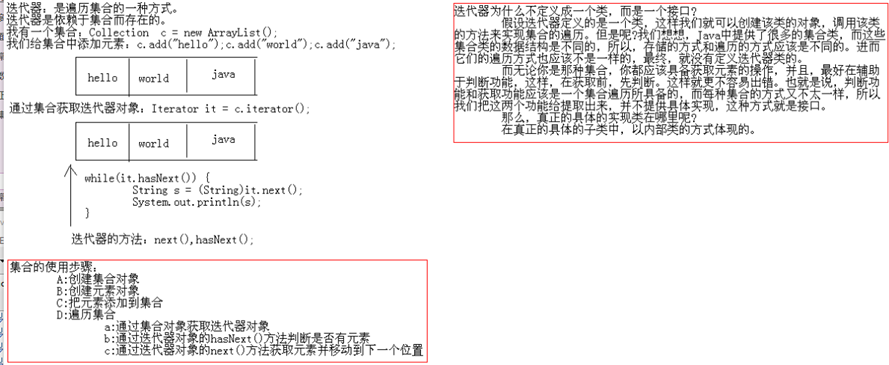深入研究容器Collection的功能方法
一.API图示

二.常用方法
0.构造函数
// Collection c = new Collection(); //错误,因为接口不能实例化
Collection c = new ArrayList();//ArrayList是Collection下的一个子类
1.添加功能
| boolean add(Object obj) |
添加一个元素 |
| boolean addAll(Collection c) |
添加一个集合的元素 |
示例1:
Collection c = new ArrayList();
System.out.println("add:"+c.add("hello"));//true,add这个方法永远返回true
示例2:添加一个集合
// 创建集合1
Collection c1 = new ArrayList();
c1.add("abc1");
c1.add("abc2");
// 创建集合2
Collection c2 = new ArrayList();
c2.add("abc1");
c2.add("abc2");
// boolean addAll(Collection c):添加一个集合的元素
System.out.println("addAll:" + c1.addAll(c2));//将c2内的所有元素添加到c1里面
2:删除功能
| void clear() |
移除所有元素 |
| boolean remove(Object o) |
移除一个元素 |
| boolean removeAll(Collection c) |
移除一个集合的元素(是一个还是所有) |
示例1:
System.out.println("remove:" + c.remove("hello"));
示例2:移除一个集合
//只要有一个元素被移除了,就返回true。
System.out.println("removeAll:"+c1.removeAll(c2));
3:判断功能
| boolean contains(Object o) |
判断集合中是否包含指定的元素 |
| boolean containsAll(Collection c) |
判断集合中是否包含指定的集合元素(是一个还是所有) |
| boolean isEmpty() |
判断集合是否为空 |
示例1:
示例2:
//只有包含所有的元素,才叫包含
System.out.println("containsAll:"+c1.containsAll(c2));
4:获取功能:迭代器的详细使用方法:迭代器(Iterator)
Iterator<E> iterator()(重点)
(1)在迭代器下的专用方法:
1)Object next():获取元素,并移动到下一个位置。
2)boolean hasNext():如果仍有元素可以迭代,则返回 true。
(2)可能出现的异常
NoSuchElementException:没有这样的元素,因为你已经找到最后了。
5:长度功能
| int size() |
元素的个数 |
6:交集功能
| boolean retainAll(Collection c) |
两个集合都有的元素?思考元素去哪了,返回的boolean又是什么意思呢? |
示例:
//假设有两个集合A,B。
//A对B做交集,最终的结果保存在A中,B不变。
//返回值表示的是A是否发生过改变。
System.out.println("retainAll:"+c1.retainAll(c2));
7:把集合转换为数组
Object[] toArray()
三.迭代器(Iterator)
1.以图会友

2.集合的普通遍历
| /** * 集合的遍历。其实就是依次获取集合中的每一个元素。 * Object[] toArray():把集合转成数组,可以实现集合的遍历 */ public class CollectionDemo3 { public static void main(String[] args) { // 创建集合对象 Collection c = new ArrayList(); // 添加元素 c.add("hello"); // Object obj = "hello"; 向上转型 // Object[] toArray():把集合转成数组,可以实现集合的遍历 Object[] objs = c.toArray(); for (int x = 0; x < objs.length; x++) { // 我知道元素是字符串,我在获取到元素的的同时,还想知道元素的长度。 // System.out.println(objs[x] + "---" + objs[x].length()); // 上面的实现不了,原因是Object中没有length()方法 // 我们要想使用字符串的方法,就必须把元素还原成字符串 // 向下转型 String s = (String) objs[x]; System.out.println(s + "---" + s.length()); } } } |
3.升级--迭代器遍历
| //Iterator iterator():迭代器,集合的专用遍历方式 public class IteratorDemo { public static void main(String[] args) { // 创建集合对象 Collection c = new ArrayList();
// 创建并添加元素 c.add("hello"); Iterator it = c.iterator(); // iterator()实际返回的肯定是子类对象,这里是多态 // 判断是否有下一个元素,有就获取,没有就不搭理它 while (it.hasNext()) { // System.out.println(it.next());第一种方式 String s = (String) it.next();//第二种,将it强转为String输出 System.out.println(s); } } } |
四.遍历练习
| /** * 问题1:能用while循环写这个程序,我能不能用for循环呢? * 问题2:不要多次使用it.next()方法,因为每次使用都是访问一个对象。 */ public class IteratorTest2 { public static void main(String[] args) { // 创建集合对象 Collection c = new ArrayList();
// 创建学生对象 Student s1 = new Student("林青霞", 27); Student s2 = new Student("风清扬", 30);
// 把学生添加到集合中 c.add(s1); c.add(s2);
// 遍历 Iterator it = c.iterator(); while (it.hasNext()) { Student s = (Student) it.next(); System.out.println(s.getName() + "---" + s.getAge());
// NoSuchElementException 不要多次使用it.next()方法,因为在一条语句中多次使用next()方法,每一次调用都会跳转到下个元素 // System.out.println(((Student) it.next()).getName() + "---" + ((Student) it.next()).getAge()); }
// for循环改写,这样做效率高,因为将it定义在了for里面,循环结束后,变量立刻销毁 // for(Iterator it = c.iterator();it.hasNext();){ // Student s = (Student) it.next(); // System.out.println(s.getName() + "---" + s.getAge()); // } } }
//上例使用到的Students类 public class Student { private String name; private int age; public Student() { super(); } public Student(String name, int age) { super(); this.name = name; this.age = age; } //get,set略 @Override public String toString() { return "Student [name=" + name + ", age=" + age + "]"; } } |
相关面试题:
1.数组有没有length()方法呢?字符串有没有length()方法呢?集合有没有length()方法呢?
2.Collection和Collections的区别?
Collection:是单列集合的顶层接口,有子接口List和Set;
Collections:是针对集合操作的工具类,有对集合进行排序和二分查找的方;
- 点赞
- 收藏
- 关注作者


评论(0)